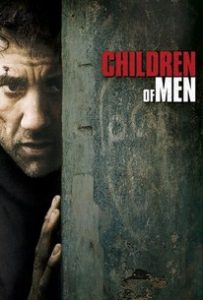
Anyone who has followed this blog with any amount of regularity knows that I am an advocate of proper structure in screenplays, especially if you’re an unknown writer who is trying to break into the business with a spec script. Using proper dramatic structure when writing your script actually frees up your creativity by providing the framework on which to hang your story. However, 3-Act structure doesn’t only work in the overall story. You should also strive to write your individual scenes in three acts as well. Every scene should have a beginning, a middle and an end with characters who want and are trying to attain something as well as characters who are trying to stop them. Each scene should start off with life in a somewhat normal state until an inciting incident gets the adventure of the scene started. Somewhere around two-thirds to three-quarters of the way through the scene there should be a moment where the hero of the scene loses everything as it relates to that scene and the third act of the scene prepares us for the next scene, which it should seamlessly slip into.
A great example of such a scene is the car scene from Children of Men.
This scene is famous mostly for the fact that it takes place entirely inside a car and moves from character to character without a cut for more than 4 minutes. If you haven’t seen this scene, please take a moment to check it out here.
This is a dynamic scene in many ways. Clearly the cinematography is amazing and there is a documentary on the special features of the DVD that shows how they accomplished the shot. What I’m more concerned about, though, is the storytelling that drives the scene. In fact this scene is a great example of a great many things, not the least of which is the fact that it looks amazing and the way it’s presented is what you remember about it, but it wouldn’t be nearly as memorable if it wasn’t so dramatic or as well told (and shown) within the context of the overall story. If you’re not familiar with the film, it takes place in the year 2027. No babies have been born for the past 18 years and the world is descending into chaos.
Act 1 of the scene
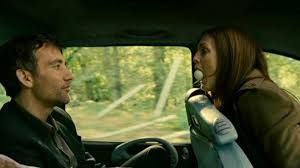
Former activist Theo Faron (Clive Owen) has been “recruited” by his former wife named Julian (Julianne Moore), who is a leader of the terrorist group called The Fishes, to use his political connections to get transfer papers for a female refugee named Kee. Faron gets the papers, but he’s required to accompany the refugee where ever she goes. The scene starts with Faron asleep in the back seat with Kee and a midwife while Julian rides in the front of the car driven by her associate Luke (Chiwetel Ejiofor). They’re traveling through a wooded area, and things couldn’t be going more smoothly. Kee wakes Faron up and tells him that he was snoring. He denies it, but Julian tells them that he always snores. Faron asks where they are and Luke tells them they’re in Canterberry and they’re close. Faron asks if there’s a hotel nearby, as Julian owes him a sexual favor for acquiring the papers. He then asks Kee if she robbed a train or blew up a building which annoys the midwife. Kee tells Julian that she said Faron was suave, and Julian tells her that he was back in his activist days, and she tells a story about how he used to trick the cops. Julian is in a more playful mood and puts a ping pong ball in her mouth and shows it to Faron. At first he refuses to play, but she spits it out and he catches it in his mouth, much impressing the others in the car. He then spits the ball at her and she catches it in her mouth. The midwife wants to see them do it again and Julian French kisses the ball back into Faron’s mouth and Faron spits it at Kee. The mood is now easy and fun until…
Act 2 of the scene
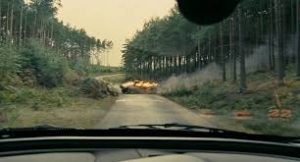
At the 1:25 mark the midwife points ahead of them and the camera whips around to the oncoming road as a flaming car hurls out of the woods and blocks the road. Luke slams on the breaks and slams the car into reverse as a mob of people come storming out of the woods and attack the car. People with torches and clubs and rocks pound at the car as the confused and terrified passengers try to make sense of what’s going on. The windshield is smashed as Luke gets the car clear of the people, but a motorcycle joins the chase. The person riding behind the driver pulls out a gun and fires, hitting Julian in the throat. The motorcycle then comes along side the car and Faron shoves open his door so that it hits the motorcycle, causing the driver to lose control and crash the bike. Faron tries to put pressure on Julian’s wound and Luke implores as to her condition and turns the car around, but Julian soon dies. Luke continues driving as…
Act 3 of the scene
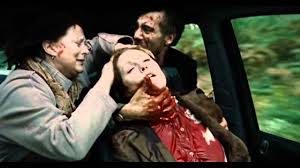
At the 2:55 mark the camera again points to the direction of the oncoming road and they’re passed by four police vehicles. They go around the corner and Luke asks if any turned around, but it was impossible to see. Very quickly a cop car appears behind them and the voice of one of the cops can be heard coming through a loudspeaker demanding that they stop the car. Claiming he can’t outrun them, Luke orders everyone to get out their passports as he pulls to the side of the road. The police come up with guns drawn as Luke tries tell them that they’re British citizens and the midwife tries to tell them they were attacked. Luke deliberately opens his door to get out and quickly pulls a hand gun, shooting both cops dead in a split second. Faron gets out of the car demanding to know what Luke is doing and Luke simply tells him to get back in the car. When Faron presses, Luke angrily points his gun at him and shouts at him to get back in the car, which Faron reluctantly does. Luke then gets back in the drivers seat and drives the car away leaving the cops lying dead on the road. and the scene cuts at 4:07.
This scene is broken into 3 roughly equal segments and each plot point changes the direction of story, as well as the direction of the car. Not only that, but there is a steady increase in the levels of tension, action and drama as the scene progresses. In fact there is a partial, yet clear Hero’s Journey in this scene as defined by Christopher Vogler in his book, The Writer’s Journey with Act I of the scene essentially serving as the archetypal Ordinary World in which the characters are simply riding in the car, seemingly without a care in the world. They Cross the First Threshold in to the Special World of the adventure when the burning car lands in front of them, blocking their path, and they find themselves in a fight for survival trying to get away from the marauders. The stakes are raised with the Supreme Ordeal, and that happens almost in the exact middle of the scene (2:07) when Julian is shot. Up to that point of Act 2 they were clearly in danger, but the appearance of the gun brought it to a whole other level. The Road Back begins Act 3 after Julian dies and Luke turns the car around with the Resurrection occurring after Luke kills the police officers. The Return with the Elixir happens as they drive away towards safety, leaving death and chaos behind them.
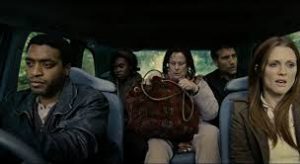
The wants and needs of the characters change throughout the scene as well. They start out on an important journey, but they have no reason to think that they’re unsafe. Suddenly and unexpectedly they’re thrust in to this dangerous and life-threatening situation where survival becomes their main goal. Finally, when they’re confronted by the police, the goal becomes escape. For reasons we’ll find out later, Luke adamantly does not want to be detained by the police, so much so that he’s willing to commit murder to prevent it. The filmmakers actually gave us the first act to get to know the characters on a more personal level so that we care and are concerned when they appear to be in danger. The simple anecdote that Julian tells about Faron does a lot to humanize both of them and also allows both of them to let their guard down to allow the audience to empathize with them. Without the first minute and a half of this scene being as effective as it is, the final two and a half minutes would not have nearly the tension that they do. It didn’t take a lot of time, but they took enough time to let us into these characters lives before they shattered them. That’s all it took to make us actually care, because the scene will lose most of its effectiveness without any emotional engagement from the audience.
This scene is brilliant on many levels. It was shot and edited in an innovative and creative way, and that’s what drew attention to it. But for me, the strongest aspect of this scene is the brilliance with which Alfonso Cuaron conceived, wrote and directed the shot where every second is more tense than the one that preceded it and the dramatic structure of the scene actually carries the action just as effectively, if not more so, than the amazing cinematography. Any aspiring screenwriter would be wise to study this scene and others like it in order to help inform their own writing.
Monument Script services can analyze individual scenes in your screenplay just as we did with this scene, and we can analyze and provide notes on the structure of your script overall. We pride ourselves on being sticklers for dramatic structure, and we can certainly help you out if your script is wanting in that capacity. Click here to see the different levels of coverage that we can offer.